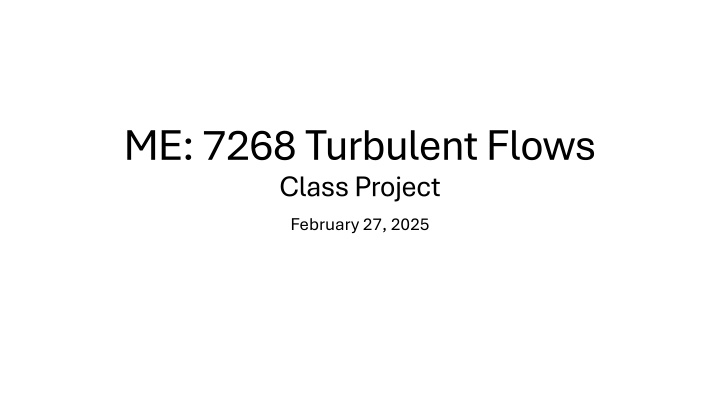
Analysis of Turbulent Flows: Velocity Statistics, Autocorrelations, and Length Scales
Explore Python and MATLAB methods for analyzing turbulent flows, including velocity statistic analysis, autocorrelations, and determining length scales using Taylor's frozen turbulence hypothesis. Learn how to extract fluctuating components, calculate Reynolds stresses, and integrate autocorrelation functions to find Taylor and Taylor micro scales.
Download Presentation

Please find below an Image/Link to download the presentation.
The content on the website is provided AS IS for your information and personal use only. It may not be sold, licensed, or shared on other websites without obtaining consent from the author. If you encounter any issues during the download, it is possible that the publisher has removed the file from their server.
You are allowed to download the files provided on this website for personal or commercial use, subject to the condition that they are used lawfully. All files are the property of their respective owners.
The content on the website is provided AS IS for your information and personal use only. It may not be sold, licensed, or shared on other websites without obtaining consent from the author.
E N D
Presentation Transcript
ME: 7268 Turbulent Flows Class Project February 27, 2025
Velocity Statistic Analysis U(t), V(t), and W(t) time series provided (filtered and unfiltered) Extract fluctuating component: Python (with NumPy): ? = np.mean(U(t), (U(t), axis=a) or mean = x.mean(axis=a) Confirm that axis a should correspond to the axis in the time direction of your array MATLAB ? = mean(U(t), (U(t),dim) Confirm that dim should correspond to axis in the time direction u(t) = U(t) - ? (and similarly for vand w) Use u(t), v(t), and w(t)to get Reynolds Stresses and TKE ????(scalar value for each dataset) Python/NumPy ?? = np.mean(u(t)*v(t)) (* operator is equivalent to np.multiplywhich is element-wise) MATLAB ?? = mean(u(t) .* v(t)) tke = (?? + ?? + ??) Ensemble average the Reynolds stresses and mean U(t) velocity from each dataset / experimental trial
Autocorrelations Python SciPy or statsmodels libraries would be good choice correlate() or acf() function names Both have direct or fft method options Both only return the resulting correlation function (need to compute the time lag vector) MATLAB autocorr() Will return correlation function and lags acf (python) and autocorr (MATLAB) also allow you specify number of lags to use Use length of time series for the nlags argument
Autocorrelation (cont.) Ensemble the autocorrelation functions together Use np.mean (Python) or mean (MATLAB) functions adjust axis or dim argument appropriately Use first 2* points to fit a parabola mirror the point at across y-axis Use points at with: np.polyfit (python) polyfit (MATLAB) Use n = 2 (second order polynomial) Both function will return coefficients for a parabola Use coefficients to plot the parabolic fit and determine E (Taylor micro scale) Can use roots function from NumPy or MATLAB or use Eqn. from instructions with 2nd derivative of RE (should be equivalent) RE Autocorrelation Functions of SDVP vortex core at x/L = 0.12
Autocorrelation (cont.) Determine the zero-crossing (ZC) point of the RE Integrate RE from 0 to ZC point to determine T (Taylor macro scale) SciPy and MATLAB should have functions you can use to do this Trapezoidal or Simpson s rule numerical integration methods recommended Not sure MATLAB has a built-in Simpson s rule integration function Convert T and E from time scales to length scales with Taylor s frozen turbulence hypothesis (TFTH) Use ensembled mean velocity from earlier statistics analysis
Report macro and micro scales Use the current results to report ensemble averaged macro and micro scale parameters Note that there is a macro scale estimate for and Macro scales to report: Use equations from instructions ?, ??, u0, u , l0, , and Rel0 Micro scales to report: Use equations in instructions f f and It is a good idea for your code to output your data to a delimted or excel file You can write to a delimited file by hand Otherwise: In Python: the Pandas library can write to an excel or CSV file for you In MATLAB: the writetable() function can write your output to excel or CSV and a micro scale estimate for
1D Energy Spectrum MATLAB and SciPy have fft functions that can be used to get E11 spectrum in the frequency domain You can take FFT of RE or using the power spectral density (PSD)/convolution approach on u(t) Both methods are given in the instructions Windowing functions may need to be used (more details to come) However, we likely will provide you with an fft function to use to ensure consistency and proper scaling of the output between everyone s results
Analyzing E11 First, convert E11 from the frequency domain wavenumber space (k1) with TFTH as per instructions: Plot (and save) E11 spectra for unscaled (freq. domain, wavenumber domain), Kolmogorov scaling, and compensated scaling (using both log-linear and linear-log axes) Scaling are included in the instructions
